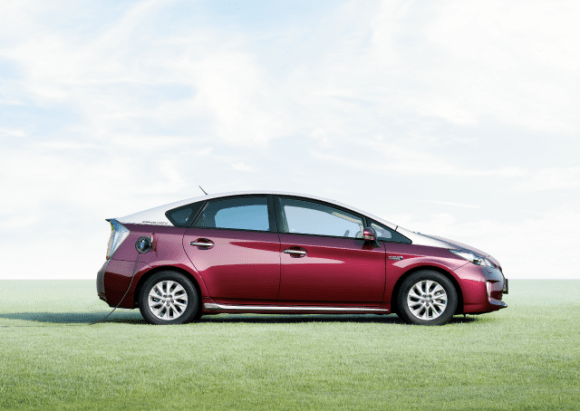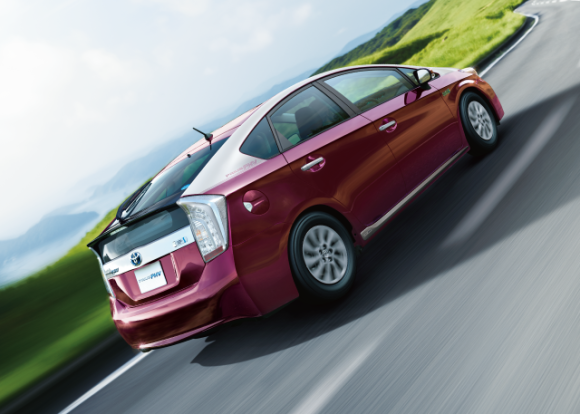
Toyota’s Prius is designed for one purpose, and it’s not to deliver the sort of exciting performance that will seduce you into taking a spirited drive through a moonlit mountain pass (that’s another car’s job). No, the Prius promise is that it will get you from Point A to Point B in the most energy-efficient way possible.
But while the standard hybrid Prius remains a popular choice for eco-conscious motorists, sales of its plug-in variant have been stagnant. Toyota is hoping to change that, though, with an updated Prius that can travel roughly twice as far under purely electric power than the current model.
If you’re the kind of person who’s more familiar with the handling differences between front-wheel, rear-wheel, and all-wheel drive than what separates one class of hybrid from another, a brief refresher on just what constitutes a plug-in hybrid may be in order. Unlike a standard hybrid vehicle, the batteries in a plug-in hybrid can be charged directly by plugging the car into a socket. By allowing the car to run in either a purely electric mode or with the electric motor and gas engine working together, plug-in hybrids seek to combine the flexibility of a normal hybrid with the efficiency and lower emissions of an all-electric vehicle.
Toyota released its first plug-in Prius, called the Prius PHV, in January of 2012. Hoping to build on the strong brand awareness and reputation of the normal hybrid Prius, the company was expecting a similarly warm response for the newer, ostensibly more advanced version of the car.
But while the Prius PHV sought to offer the advantages of both a hybrid and all-electric mode, it couldn’t deliver on the latter for very long. From a full charge, the current Prius PHV can only run 26.4 kilometers (16.4 miles) in full-electric mode before its batteries are drained, meaning that unless you’re headed someplace fairly close, you’re going to need to burn a little gas to get there and back.
Car buyers haven’t seen that as much of an advantage, especially considering that prices for the Prius PHV start at 2,931,429 yen (US$24,634), more than 30 percent more than the ordinary Prius hybrid, which is priced from 2,232,000 yen. The end result is lackluster sales numbers, and three years and three months after its launch, Toyota has only found some 20,000 buyers for the Prius PHV, a mere fifth of what the company was hoping for in that time frame.
In contrast, rival Mitsubishi Motors has enjoyed great success with its Outlander PHEV plug-in hybrid SUV, which boasts a 60.2-kilometer all-electric range. Even with its much higher price (starting at 4,123,440 yen), Mitsubishi has been selling Outlander PHEVs at a brisk pace, moving 13,000 in 2015 alone.
This sales gap has shown Toyota that it needs to step up its game, and the company has announced that the Prius PHV will be getting an update. Equipped with an increased quantity of batteries, and also thanks to weight-saving measures in other parts of the vehicle, Toyota is promising that the refreshed Prius PHV will be able to travel more than 50 kilometers in its all-electric mode, a distance roughly twice what the current model is capable of.
The new Prius PHV is expected to arrive at dealers in the fall of 2016. In the meantime, grab a map and start plotting out all the new places you’ll be able to go without needing a drop of gas.
Source: Tokyo Shimbun
Top image: Toyota (edited by RocketNews24)
Insert images: Toyota, Mitsubishi Motors (edited by RocketNews24)



 Japan’s hydrogen fuel cell stations begin to open, but are they worth the switch?
Japan’s hydrogen fuel cell stations begin to open, but are they worth the switch? New smartphone game turns car models into anime girls with model-worthy looks
New smartphone game turns car models into anime girls with model-worthy looks Toyota goes full otaku, makes 40 kawaii mascots for every part of the car
Toyota goes full otaku, makes 40 kawaii mascots for every part of the car Honda readying a Fuel Cell Vehicle for buyers next year, just in time to challenge Toyota
Honda readying a Fuel Cell Vehicle for buyers next year, just in time to challenge Toyota The most fun I’ve had behind the wheel this year was with Toyota’s unusual vision for the future of mobility
The most fun I’ve had behind the wheel this year was with Toyota’s unusual vision for the future of mobility Foreigner’s request for help in Tokyo makes us sad for the state of society
Foreigner’s request for help in Tokyo makes us sad for the state of society Japanese city loses residents’ personal data, which was on paper being transported on a windy day
Japanese city loses residents’ personal data, which was on paper being transported on a windy day Akihabara pop-up shop sells goods made by Japanese prison inmates
Akihabara pop-up shop sells goods made by Japanese prison inmates Historical figures get manga makeovers from artists of Spy x Family, My Hero Academia and more
Historical figures get manga makeovers from artists of Spy x Family, My Hero Academia and more Red light district sushi restaurant in Tokyo shows us just how wrong we were about it
Red light district sushi restaurant in Tokyo shows us just how wrong we were about it Ghibli Park now selling “Grilled Frogs” from food cart in Valley of Witches
Ghibli Park now selling “Grilled Frogs” from food cart in Valley of Witches Green tea ice cream from Nara combines everything we love about the city into one cute dessert
Green tea ice cream from Nara combines everything we love about the city into one cute dessert We try out “Chan Ramen”, an underground type of ramen popular in the ramen community
We try out “Chan Ramen”, an underground type of ramen popular in the ramen community Beautiful Red and Blue Star luxury trains set to be Japan’s new Hokkaido travel stars
Beautiful Red and Blue Star luxury trains set to be Japan’s new Hokkaido travel stars The oldest tunnel in Japan is believed to be haunted, and strange things happen when we go there
The oldest tunnel in Japan is believed to be haunted, and strange things happen when we go there McDonald’s new Happy Meals offer up cute and practical Sanrio lifestyle goods
McDonald’s new Happy Meals offer up cute and practical Sanrio lifestyle goods Japanese ramen restaurants under pressure from new yen banknotes
Japanese ramen restaurants under pressure from new yen banknotes French Fries Bread in Tokyo’s Shibuya becomes a hit on social media
French Fries Bread in Tokyo’s Shibuya becomes a hit on social media Studio Ghibli releases new action figures featuring Nausicaä of the Valley of the Wind characters
Studio Ghibli releases new action figures featuring Nausicaä of the Valley of the Wind characters New private rooms on Tokaido Shinkansen change the way we travel from Tokyo to Kyoto
New private rooms on Tokaido Shinkansen change the way we travel from Tokyo to Kyoto Tokyo Tsukiji fish market site to be redeveloped with 50,000-seat stadium, hotel, shopping center
Tokyo Tsukiji fish market site to be redeveloped with 50,000-seat stadium, hotel, shopping center All-you-can-drink Starbucks and amazing views part of Tokyo’s new 170 meter-high sky lounge
All-you-can-drink Starbucks and amazing views part of Tokyo’s new 170 meter-high sky lounge Beautiful Ghibli sealing wax kits let you create accessories and elegant letter decorations【Pics】
Beautiful Ghibli sealing wax kits let you create accessories and elegant letter decorations【Pics】 Studio Ghibli releases Kiki’s Delivery Service chocolate cake pouches in Japan
Studio Ghibli releases Kiki’s Delivery Service chocolate cake pouches in Japan New definition of “Japanese whiskey” goes into effect to prevent fakes from fooling overseas buyers
New definition of “Japanese whiskey” goes into effect to prevent fakes from fooling overseas buyers Our Japanese reporter visits Costco in the U.S., finds super American and very Japanese things
Our Japanese reporter visits Costco in the U.S., finds super American and very Japanese things Studio Ghibli unveils Mother’s Day gift set that captures the love in My Neighbour Totoro
Studio Ghibli unveils Mother’s Day gift set that captures the love in My Neighbour Totoro More foreign tourists than ever before in history visited Japan last month
More foreign tourists than ever before in history visited Japan last month New Pokémon cakes let you eat your way through Pikachu and all the Eevee evolutions
New Pokémon cakes let you eat your way through Pikachu and all the Eevee evolutions Sales of Japan’s most convenient train ticket/shopping payment cards suspended indefinitely
Sales of Japan’s most convenient train ticket/shopping payment cards suspended indefinitely Sold-out Studio Ghibli desktop humidifiers are back so Totoro can help you through the dry season
Sold-out Studio Ghibli desktop humidifiers are back so Totoro can help you through the dry season Japanese government to make first change to romanization spelling rules since the 1950s
Japanese government to make first change to romanization spelling rules since the 1950s Ghibli founders Toshio Suzuki and Hayao Miyazaki contribute to Japanese whisky Totoro label design
Ghibli founders Toshio Suzuki and Hayao Miyazaki contribute to Japanese whisky Totoro label design Doraemon found buried at sea as scene from 1993 anime becomes real life【Photos】
Doraemon found buried at sea as scene from 1993 anime becomes real life【Photos】 Tokyo’s most famous Starbucks is closed
Tokyo’s most famous Starbucks is closed One Piece characters’ nationalities revealed, but fans have mixed opinions
One Piece characters’ nationalities revealed, but fans have mixed opinions We asked a Uniqlo employee what four things we should buy and their suggestions didn’t disappoint
We asked a Uniqlo employee what four things we should buy and their suggestions didn’t disappoint Princesses, fruits, and blacksmiths: Study reveals the 30 most unusual family names in Japan
Princesses, fruits, and blacksmiths: Study reveals the 30 most unusual family names in Japan Japanese researchers redesign electric car to go farther than ever before on a single charge
Japanese researchers redesign electric car to go farther than ever before on a single charge Chinese stuntman sets Guinness record for fastest lap on Nurburgring using only two-wheels
Chinese stuntman sets Guinness record for fastest lap on Nurburgring using only two-wheels Hugh Jackman stars, sings J-pop cover, and speaks Japanese in ads for Toyota【Videos】
Hugh Jackman stars, sings J-pop cover, and speaks Japanese in ads for Toyota【Videos】 The Chirori is a compact traditional Japanese cooking hearth for your modern home
The Chirori is a compact traditional Japanese cooking hearth for your modern home Tokyo Motor Show set to reveal the new concept Toyota SF-R, which looks surprisingly like Pikachu
Tokyo Motor Show set to reveal the new concept Toyota SF-R, which looks surprisingly like Pikachu Toyota’s Prius c Journeys through Dragon Quest and Monster Hunter
Toyota’s Prius c Journeys through Dragon Quest and Monster Hunter Toyota proposes a future where cars become pizza shops, hotels, and occasionally cars too
Toyota proposes a future where cars become pizza shops, hotels, and occasionally cars too Freaky veggies trending in Japanese groceries, possible precursor to real-life “The Last of Us”
Freaky veggies trending in Japanese groceries, possible precursor to real-life “The Last of Us” How to turn Cup Noodle instant ramen into delicious Osaka-style dumplings【SoraKitchen】
How to turn Cup Noodle instant ramen into delicious Osaka-style dumplings【SoraKitchen】 Nissan unveils the world’s first “Intelligent Parking Chair”【Video】
Nissan unveils the world’s first “Intelligent Parking Chair”【Video】 Tokyo University research team develops world’s first hybrid robot with real working muscles
Tokyo University research team develops world’s first hybrid robot with real working muscles Toyota’s new Mark X car paints a picture that depicts its Japanese roots【Video】
Toyota’s new Mark X car paints a picture that depicts its Japanese roots【Video】 Pokémon GO players in Japan discover strange new hybrid species of monsters in the game
Pokémon GO players in Japan discover strange new hybrid species of monsters in the game Traditional sakura mochi meets Western cake with gorgeous and tantalizing results!
Traditional sakura mochi meets Western cake with gorgeous and tantalizing results! Toyota’s wooden concept car serves as a time capsule for generations to come
Toyota’s wooden concept car serves as a time capsule for generations to come
Leave a Reply